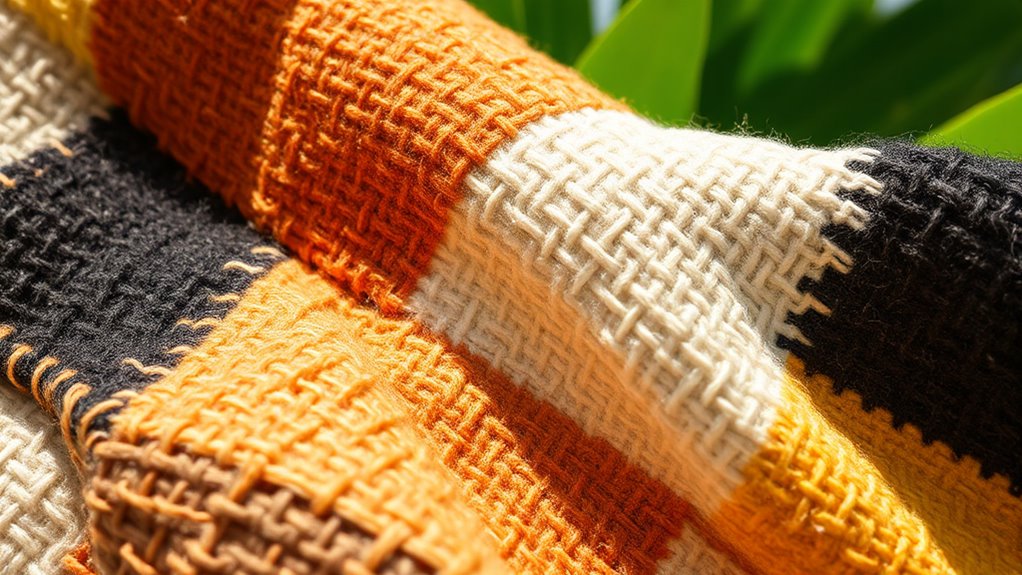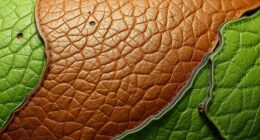Sustainable fabrics like organic cotton and recycled textiles help you reduce water use and lessen environmental harm. Organic cotton uses rain-fed irrigation and eco-friendly farming methods, while recycled textiles are made from post-consumer waste, cutting water needs in production. These fabrics also support water conservation and pollution reduction, making your choices more eco-friendly. If you keep exploring, you’ll discover how these materials can make a positive impact on the planet.
Key Takeaways
- Organic cotton uses water-efficient farming methods like rain-fed irrigation, reducing water consumption compared to conventional cotton.
- Recycled textiles are made from post-consumer waste, significantly lowering water use during manufacturing and processing.
- Sustainable fabrics often incorporate water-saving dyeing techniques, minimizing water pollution and overall consumption.
- Using organic cotton and recycled textiles supports water conservation, protecting ecosystems and local communities.
- Adoption of these fabrics promotes environmentally responsible consumer choices and industry-wide eco-friendly practices.

Water conservation is another critical aspect of sustainable fabric production. Conventional textile manufacturing consumes massive amounts of water, often leading to depleted water sources and polluted streams. Sustainable fabrics like organic cotton and recycled textiles are produced using water-efficient processes. Organic cotton farms typically employ methods that minimize water use, such as rain-fed irrigation and crop rotation, which help preserve local water supplies. Recycled textiles, especially those made from post-consumer waste, require appreciably less water during manufacturing since they skip many of the water-intensive steps involved in creating new fibers. By choosing these fabrics, you actively support water conservation efforts, helping to sustain communities and ecosystems that depend on clean water sources. Incorporating mindfulness practices into your shopping habits can also increase awareness of sustainable choices and positively influence your overall environmental impact. When you opt for sustainable fabrics, you’re also endorsing innovations in dyeing techniques that further reduce water usage. Many brands now adopt digital or low-impact dyeing methods, which cut water consumption dramatically compared to traditional methods. These advancements make it possible to enjoy fashion without the guilt of contributing to water scarcity or pollution. Additionally, sustainable textiles are often produced using renewable energy sources, further decreasing their environmental impact.
Frequently Asked Questions
How Does Organic Cotton Impact Local Farming Communities?
Organic cotton positively impacts local farming communities by promoting sustainable practices through organic farming methods. These practices reduce chemical use, improve soil health, and guarantee safer working conditions. As a result, community empowerment grows because farmers gain access to healthier environments and fairer markets. You’ll see stronger local economies, better livelihoods, and a more resilient community, all driven by the shift toward organic farming and sustainable textile production.
Are Recycled Textiles as Durable as New Fabrics?
Recycled textiles can be just as durable as new fabrics, but it depends on the material performance and fabric longevity. You might notice some variations, especially with fibers like polyester, which often maintain strength over time. Proper care also plays a big role in ensuring recycled textiles last, so you can confidently use them knowing they’re built to endure, just like their new counterparts.
What Certifications Verify Sustainable Fabric Claims?
They say, “Trust but verify,” and that’s true for sustainable fabric claims. Certification standards like GOTS, OEKO-TEX, and Fair Trade guarantee your fabrics meet eco-friendly benchmarks. Eco label verification confirms these claims, giving you confidence in their sustainability. Always check for these certifications before buying; they’re your best guarantee that the fabrics you choose truly support environmental and social responsibility.
How Can Consumers Identify Genuine Organic or Recycled Textiles?
You can identify genuine organic or recycled textiles by carefully reading fabric labeling, which should display recognized certifications like GOTS or OEKO-TEX. Stay informed through consumer awareness campaigns that educate you on what to look for. Always check labels for certification logos and detailed fabric information, ensuring the product truly meets sustainability standards. This helps you make responsible choices and supports eco-friendly practices in the textile industry.
What Are the Environmental Benefits of Choosing Recycled Fabrics?
Choosing recycled fabrics benefits the environment by reducing textile waste through textile recycling, which minimizes landfill overflowing and pollution. It also decreases the need for virgin materials, conserving water and energy. Recycled textiles often use eco-friendly dyes, reducing harmful chemical runoff. By making this choice, you help lower carbon emissions and promote a more sustainable fashion industry, supporting eco-conscious practices and protecting the planet for future generations.
Conclusion
Now that you’ve discovered the benefits of organic cotton and recycled textiles, you might think you’ve seen it all. But there’s a whole world of innovative sustainable fabrics waiting to be explored—materials that could change the way you shop and style forever. Will you take the leap and embrace these eco-friendly options? The future of fashion is in your hands, and the next breakthrough could be just around the corner. Are you ready to find out what’s next?









